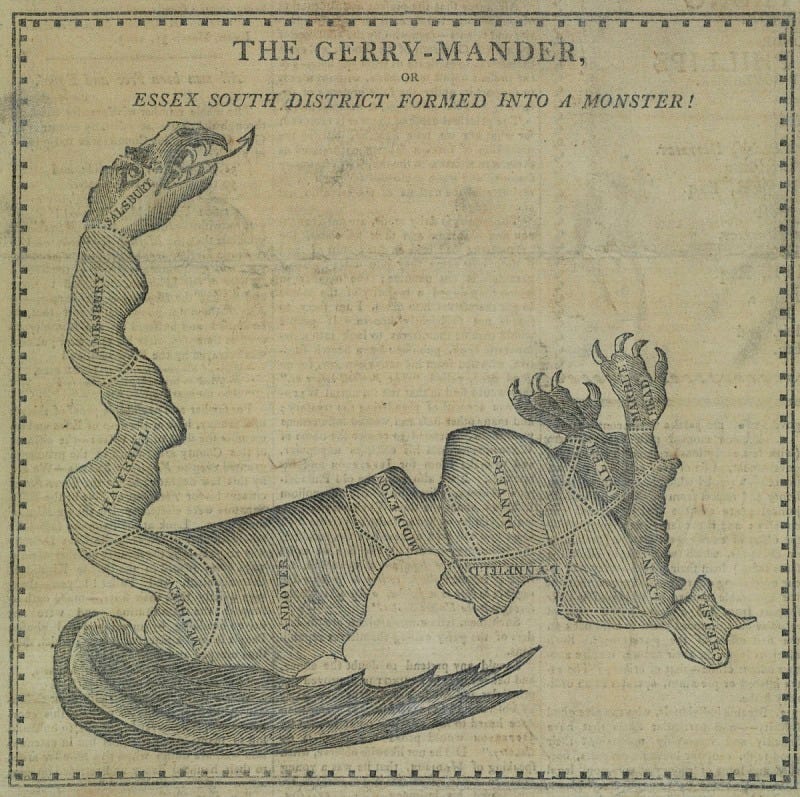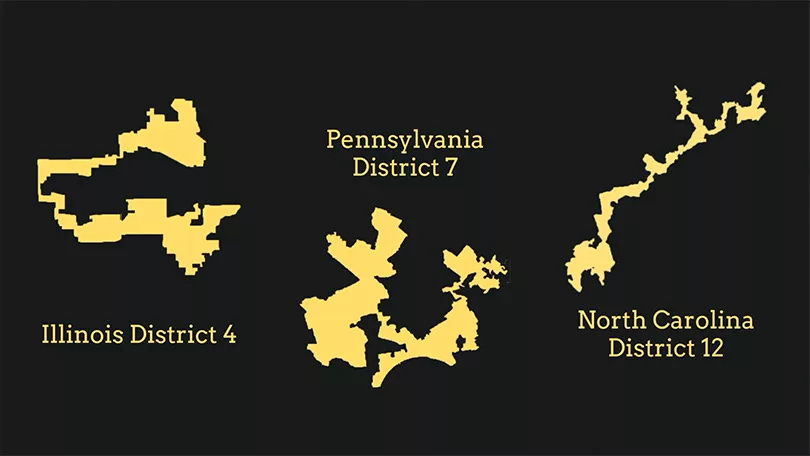Gerrymandering is Government Corruption
And it may be on the ballot near you.
By March 1812, Elbridge Gerry had already made quite a name for himself. He had signed the Declaration of Independence, acted as a delegate to the Constitutional Convention in Philadelphia, and was serving his second term as governor of Massachusetts.
John Adams was a big fan, writing in July 1776, “If every Man here was a Gerry, the Liberties of America would be safe against the Gates of Earth and Hell.” Gerry fought hard to convince his fellow founding fathers that America needed to be separate from Great Britain.
Gerry was a bit of an awkward man, with wild-eyes and an eccentric personality. He was known to have a unique way of thinking about problems, a keen attention to detail, and a short temper.
But in 1812, he also became known for something else, when a political cartoon published in the Boston Gazette showed a monster named the “Gerry-Mander.” The image is of a map of Massachusetts’ voting districts, drawn in the shape of a beast with wings and claws — it even had a forked-tongue, like some sort of demonic salamander or dragon.
The cartoon was a representation of a new map of voting districts that the state’s Democratic-Republicans had drawn, which benefited their own party. Gerry, a member of the party, had signed off on the plan that February, much to the chagrin of the opposing party, the Federalists, who placed the cartoon in the paper in response.
Other newspapers picked it up across the state, and Gerry’s name soon became synonymous with the practice of “gerrymandering” or when politicians redraw voting districts to gain and maintain their own political power.
But here’s the thing — Gerry (who’s name is actually pronounced with a hard G, like Gary, not Jerry) did not invent gerrymandering. The practice had already been around for a long time. And Gerry himself didn’t really have a role or a big responsibility in the creation of the maps.
However, the Massachusetts maps that year were particularly brazen in how political they were. Though the Democratic Republicans received less than 50% of the vote, they won more than 70 of the seats in the state’s Senate.
The Federalists eventually regained their seats, and they in turn redrew the districts.
And the cycle continued.
Gerrymandering continues to be a massive problem in the US, and interestingly, it is only a problem in the US. Almost every other country in the world has found a way to fix the problem of the politicians, not the people, having control over political mapping.
There’s more than one way to gerrymander a map. One way is to configure the shape of the district to encompass only voters who are likely to vote blue or red. Using demographic information, the politicians drawing the map might figure out which nine digit zip codes vote one way or another, and draw a shape that seems to make no logical sense, but makes all the sense in the world when you realize that its purpose is not fairness, but partisanship.
Another way to gerrymander is to divide groups that tend to vote similarly into multiple districts so they cannot vote as a bloc. For example, if there are large immigrant communities who tend to vote one way, they may put half in one district and half in another to dilute the power of their votes.
Either of these methods have the same goal: allowing political parties to pick their voters instead of voters getting to pick their politicians.
How is gerrymandering legal, you might ask? The short answer is that the Supreme Court said it’s fine, as long as the gerrymandering does not interfere with the Voting Rights Act. Gerrymandering to keep the Republicans or the Democrats in power? Yes. Gerrymandering to dilute the power of minority voters? No.
And in this year’s election, gerrymandering is on the ballot in Ohio.
Ohio is one of the most gerrymandered states in the country. More than ¾ of Ohio residents live in districts that are so gerrymandered that the opposing party has little hope of being elected.
Last year a group called Citizens Not Politicians submitted more than 700,000 petition signatures from 57 Ohio counties in order to get an amendment on the state’s ballot for the November 5 election.
The amendment would get rid of the current Ohio Redistricting Commission (made up of a group of politicians) and replace it with a commission made up of 15 independent members. The members would represent “all political parties, different geographical areas and the demographics of the state,” according to Citizens Not Politicians.
Research suggests that the most fair way to draw voting districts is to create a citizens’ council made up of a broad cross section of people from all walks of life and political beliefs.
Similar ballot initiatives like the one Ohio is proposing have worked in other places, like Colorado, Michigan, Missouri, and Utah.
Democracies thrive with robust competition. Every district possible should be a competitive one. Voters deserve to be allowed to make a choice between legitimate candidates from multiple parties in every election, and all elected officials should have to work to earn the votes of the people they represent.
I’d love to know: is your state gerrymandered, or has it found a way to solve this governmental corruption problem?







I live in Ohio and I'm so excited to vote on this issue in November. We've been so frustrated with the maps here for years.
I live in Illinois and can attest to the fact that Gerrymandering has resulted in losing Republican seats. The state has supermajority of democrats in all offices. The problem with supermajorities is that there is nothing to prevent them from doing whatever they want. There are no checks and balances. We need strong representation for both parties, for all voters. I know it’s also happening in Red states. I’m against Gerrymandering regardless of who benefits. It’s just wrong and hurts democracy.